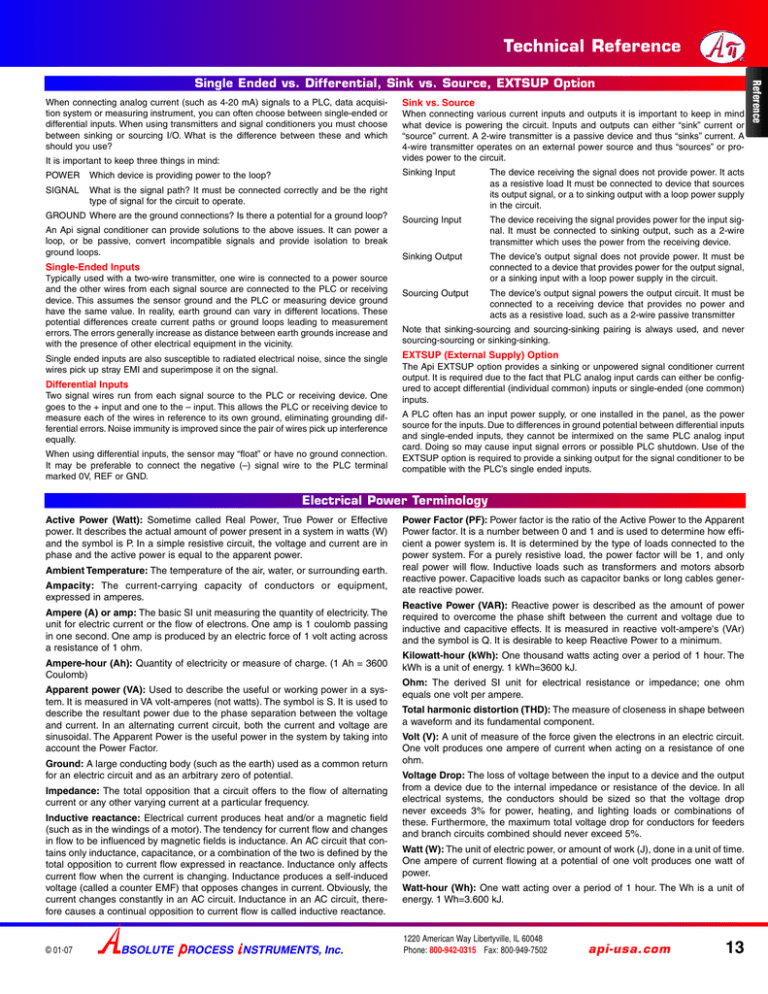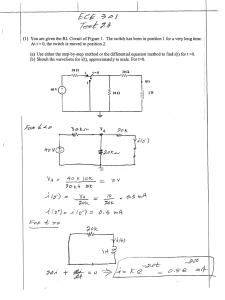Sink vs Source
advertisement

Technical Reference When connecting analog current (such as 4-20 mA) signals to a PLC, data acquisition system or measuring instrument, you can often choose between single-ended or differential inputs. When using transmitters and signal conditioners you must choose between sinking or sourcing I/O. What is the difference between these and which should you use? Sink vs. Source It is important to keep three things in mind: When connecting various current inputs and outputs it is important to keep in mind what device is powering the circuit. Inputs and outputs can either “sink” current or “source” current. A 2-wire transmitter is a passive device and thus “sinks” current. A 4-wire transmitter operates on an external power source and thus “sources” or provides power to the circuit. POWER Which device is providing power to the loop? Sinking Input SIGNAL What is the signal path? It must be connected correctly and be the right type of signal for the circuit to operate. The device receiving the signal does not provide power. It acts as a resistive load It must be connected to device that sources its output signal, or a to sinking output with a loop power supply in the circuit. GROUND Where are the ground connections? Is there a potential for a ground loop? Sourcing Input An Api signal conditioner can provide solutions to the above issues. It can power a loop, or be passive, convert incompatible signals and provide isolation to break ground loops. The device receiving the signal provides power for the input signal. It must be connected to sinking output, such as a 2-wire transmitter which uses the power from the receiving device. Sinking Output The device’s output signal does not provide power. It must be connected to a device that provides power for the output signal, or a sinking input with a loop power supply in the circuit. and the other wires from each signal source are connected to the PLC or receiving device. This assumes the sensor ground and the PLC or measuring device ground have the same value. In reality, earth ground can vary in different locations. These potential differences create current paths or ground loops leading to measurement errors. The errors generally increase as distance between earth grounds increase and with the presence of other electrical equipment in the vicinity. Sourcing Output The device’s output signal powers the output circuit. It must be connected to a receiving device that provides no power and acts as a resistive load, such as a 2-wire passive transmitter Single ended inputs are also susceptible to radiated electrical noise, since the single wires pick up stray EMI and superimpose it on the signal. EXTSUP (External Supply) Option Single-Ended Inputs Typically used with a two-wire transmitter, one wire is connected to a power source Differential Inputs Two signal wires run from each signal source to the PLC or receiving device. One goes to the + input and one to the – input. This allows the PLC or receiving device to measure each of the wires in reference to its own ground, eliminating grounding differential errors. Noise immunity is improved since the pair of wires pick up interference equally. When using differential inputs, the sensor may “float” or have no ground connection. It may be preferable to connect the negative (–) signal wire to the PLC terminal marked 0V, REF or GND. Note that sinking-sourcing and sourcing-sinking pairing is always used, and never sourcing-sourcing or sinking-sinking. The Api EXTSUP option provides a sinking or unpowered signal conditioner current output. It is required due to the fact that PLC analog input cards can either be configured to accept differential (individual common) inputs or single-ended (one common) inputs. A PLC often has an input power supply, or one installed in the panel, as the power source for the inputs. Due to differences in ground potential between differential inputs and single-ended inputs, they cannot be intermixed on the same PLC analog input card. Doing so may cause input signal errors or possible PLC shutdown. Use of the EXTSUP option is required to provide a sinking output for the signal conditioner to be compatible with the PLC’s single ended inputs. Electrical Power Terminology Active Power (Watt): Sometime called Real Power, True Power or Effective power. It describes the actual amount of power present in a system in watts (W) and the symbol is P. In a simple resistive circuit, the voltage and current are in phase and the active power is equal to the apparent power. Ambient Temperature: The temperature of the air, water, or surrounding earth. Ampacity: The current-carrying capacity of conductors or equipment, expressed in amperes. Ampere (A) or amp: The basic SI unit measuring the quantity of electricity. The unit for electric current or the flow of electrons. One amp is 1 coulomb passing in one second. One amp is produced by an electric force of 1 volt acting across a resistance of 1 ohm. Ampere-hour (Ah): Quantity of electricity or measure of charge. (1 Ah = 3600 Coulomb) Apparent power (VA): Used to describe the useful or working power in a system. It is measured in VA volt-amperes (not watts). The symbol is S. It is used to describe the resultant power due to the phase separation between the voltage and current. In an alternating current circuit, both the current and voltage are sinusoidal. The Apparent Power is the useful power in the system by taking into account the Power Factor. Ground: A large conducting body (such as the earth) used as a common return for an electric circuit and as an arbitrary zero of potential. Impedance: The total opposition that a circuit offers to the flow of alternating current or any other varying current at a particular frequency. Inductive reactance: Electrical current produces heat and/or a magnetic field (such as in the windings of a motor). The tendency for current flow and changes in flow to be influenced by magnetic fields is inductance. An AC circuit that contains only inductance, capacitance, or a combination of the two is defined by the total opposition to current flow expressed in reactance. Inductance only affects current flow when the current is changing. Inductance produces a self-induced voltage (called a counter EMF) that opposes changes in current. Obviously, the current changes constantly in an AC circuit. Inductance in an AC circuit, therefore causes a continual opposition to current flow is called inductive reactance. © 01-07 BSOLUTE ROCESS NSTRUMENTS, Inc. Power Factor (PF): Power factor is the ratio of the Active Power to the Apparent Power factor. It is a number between 0 and 1 and is used to determine how efficient a power system is. It is determined by the type of loads connected to the power system. For a purely resistive load, the power factor will be 1, and only real power will flow. Inductive loads such as transformers and motors absorb reactive power. Capacitive loads such as capacitor banks or long cables generate reactive power. Reactive Power (VAR): Reactive power is described as the amount of power required to overcome the phase shift between the current and voltage due to inductive and capacitive effects. It is measured in reactive volt-ampere's (VAr) and the symbol is Q. It is desirable to keep Reactive Power to a minimum. Kilowatt-hour (kWh): One thousand watts acting over a period of 1 hour. The kWh is a unit of energy. 1 kWh=3600 kJ. Ohm: The derived SI unit for electrical resistance or impedance; one ohm equals one volt per ampere. Total harmonic distortion (THD): The measure of closeness in shape between a waveform and its fundamental component. Volt (V): A unit of measure of the force given the electrons in an electric circuit. One volt produces one ampere of current when acting on a resistance of one ohm. Voltage Drop: The loss of voltage between the input to a device and the output from a device due to the internal impedance or resistance of the device. In all electrical systems, the conductors should be sized so that the voltage drop never exceeds 3% for power, heating, and lighting loads or combinations of these. Furthermore, the maximum total voltage drop for conductors for feeders and branch circuits combined should never exceed 5%. Watt (W): The unit of electric power, or amount of work (J), done in a unit of time. One ampere of current flowing at a potential of one volt produces one watt of power. Watt-hour (Wh): One watt acting over a period of 1 hour. The Wh is a unit of energy. 1 Wh=3.600 kJ. 1220 American Way Libertyville, IL 60048 Phone: 800-942-0315 Fax: 800-949-7502 api-usa.com 13 Reference Single Ended vs. Differential, Sink vs. Source, EXTSUP Option


